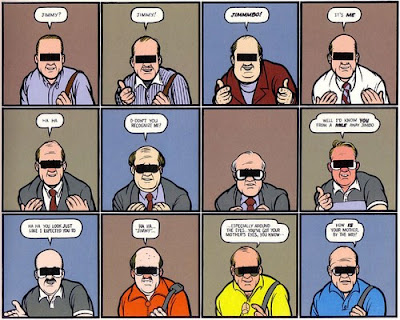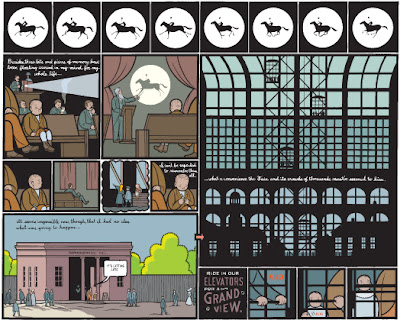In a promotional event from nearly a decade ago, American cartoonist Chris Ware, the author of the 2000 graphic novel Jimmy Corrigan: The Smartest Kid On Earth could well have been mistaken for his most famous character; an oddly shapeless face, scared-looking eyes, severely receding hairline, and in his late thirties (Corrigan is 36), showing every possible outward sign of premature ageing. Jimmy Corrigan, who first appeared in Acme Novelty Library (Ware’s comic book series) in a serialized comic strip between 1995 and 2000, also struggles to come to terms with the sudden appearance of an absentee father in his life, mirroring Ware’s own experience with his own biological father, from whom he received a phone call one day, out of the cold. The aforementioned father then stood Ware up for what would have been only their second meeting in person, soon after which he died of a coronary. In the searing, heartfelt postscript to Jimmy Corrigan, Ware reflected that he began writing and drawing the comic partially in order to “work out” his issues with his absconding father, en route to maybe getting to really know him, only to realize that “Real life, of course, is much more badly plotted than that”. Ware goes on to note that the time taken by the average reader to read this novel would be “four or five hours” which "is almost exactly the total time I ever spent with my father, either in person or on the phone".
Bleakly funny, even (dare I say it?) Kafkaesque reflections like these are very often the bulwark of Ware’s novel, which chronicles paternal neglect, existential angst and societal alienation across three generations of the fictional Corrigans, an Irish-American immigrant family. Determinedly non-linear, with a structural and narrative intricacy which would give most postmodern prose writers a run for their money, Jimmy Corrigan marked a watershed in the “alternative comics” movement which has been gaining momentum rapidly in recent years, with the likes of Daniel Clowes, Lynda Barry, Jason Lutes, Chester Brown, Paul Hornschmeier, the Hernandez Brothers and others proving that for followers of graphic literature, there’s life beyond Alan Moore, Art Spiegelman or Neil Gaiman.
Jimmy Corrigan, the 36 year old protagonist of the novel, lives shackled both by his mind-numbingly dull desk job and his over-protective, overbearing mother. Jimmy has all the self-confidence of a lifelong wallflower. Having never known his real father, Jimmy collects father figures as he meekly goes through the motions of his banal existence. (The most notable of these is “The Super-Man” Ware’s washed-out, deadbeat take on the world’s favorite superhero, whose one-night stand with young Jimmy’s mother, and subsequent suicide in front of an adult Jimmy set the grim tone of the book in the first dozen or so pages) Following a letter he receives out of the blue, Jimmy goes on to meet his real father; only it isn’t merely his father he meets, but also his grandfather (also named James Corrigan) and an African-American stepsister he never knew he had.
Chris Ware’s artwork has quite a few things which are immediately distinctive; his use of sheer, block colours (he uses a computer for colouring, and as such this practice can feel a lot like a child colouring by numbers), a high degree of ambiguity or deliberate obfuscation in facial detailing, circuit-diagram like full page-panels etc. (Ware also peppers the book with elaborate, detailed plans for making miniature paper cut-outs of Jimmy and other related paraphernalia) However, the one feature of his art which lingers in the mind is the incredible detailing and the geometrical precision of his panels, lending a very Arabic miniature-like feel to the work. A lot of his panels are less than half an inch length and breadth-wise, which makes the use of a magnifying glass very plausible advice indeed. (As Ware once explained himself, this is quite deliberate; the size of the actual drawings is about twice of what we see on the pages of Jimmy Corrigan.) Ware also heavily employs the stream-of-consciousness technique to bring out some of the more macabre and disturbing aspects of Jimmy’s inner life.
Chris Ware the writer is no lightweight either: The understandably awkward initial exchanges between Jimmy and his father are handled with a surety of purpose and a lightness of touch which elevates these portions of the book above their firmly formulaic content. This is even more apparent whenever the narrative shifts to James Corrigan the elder, another awkward, socially insecure living under the thumb of a domineering single parent, in this case the father, who very obviously has no great affection for his only child. In a particularly touching passage, young James witnesses his generally stern father’s forbidding exterior crumbling; when faced the death of his own mother, James’ grandmother. (Line breaks indicate change of panel)
“And while
he might have readied himself for harsh words, rough handling or even a slap
nothing prepared this boy
for the unchecked sobs
of a child
anticipating
the imminent loss of his mother”
he might have readied himself for harsh words, rough handling or even a slap
nothing prepared this boy
for the unchecked sobs
of a child
anticipating
the imminent loss of his mother”
Or when James seeks solace in the kindly father of a newfound friend from school; and with all the innocence of his age, secretly hopes that they adopt him into their already burgeoning family. (“Although this hyperbolic praise was subsequently spread amongst all the participants with the judiciousness one might expect from a parent of many, I reveled in his acclaim, and shortly concluded that he had singled me out as his favorite”)
A recurring obsession with Ware is the nature of memory, and the mechanism of fashioning a story out of real-life experiences. For instance, when James is narrating the story of how his father took him to Chicago
The Columbian Exhibition or the World’s Fair of 1893 is depicted with virtuosic skill, as Ware lovingly renders architectural and other period details. These panels are among the strongest of the novel, as Ware showcases the scale and the depth of his vision, keeping several balls in the air, with James realizing the hard-to-swallow truth about his own father even as he, along with the reader is utterly mesmerized by the stunning visuals all around him. Whether it’s a typically featureless African-American in the corner of a panel, playing an old six-string with a “Rag Time” board next to him; (Ware is a ragtime enthusiast himself, and occasionally publishes a 200 page journal dedicated to the same) or a page-length panel depicting hundreds of children in red, blue and white forming the U.S. flag in formation, Ware raises the game to dizzying levels.
The World’s Fair is also a convenient way for Ware to indulge in another, much broader theme: the power of the comics medium itself, and the idea of comics as a sort of “fourth dimension”, given its unique powers of simulating motion or the passage of time. James’ father, i.e. Jimmy’s great-grandfather, is helping a certain “Mister E. Muybridge” to construct the “Zoopraxographical Hall” for his exhibit at the Fair. The real-life Eadweard Muybridge was an early pioneer of cinematic techniques, and the “Zoopraxography” being talked about was one such method, where rapidly rotating glass discs were used to create the illusion of motion, in particular, the illusion of a galloping horse, something which is depicted faithfully and accurately later on in the book. The parallels are not difficult to draw here; a profusion of gradually varying drawings being used in animation since a long time. This is also slyly hinted at in the preface of the book, where a tongue-in-cheek Ware describes the “New Pictorial Language” (with an illustrated example) which is supposed to be “Good for Showing Stuff. Leaving out Big Words” and is “superior to the zoetrope” and could even be “the culmination of over two thousand years of civilized endeavour, and the highest expression of man’s achievement yet to appear.”
Jimmy Corrigan can be a little taxing on the reader sometimes, not least because of the sheer amount of information being conveyed out of every square inch of every page, right down to the front and back covers, filled with little jokes in faux-grandiose, archaic language. However, this is a small criticism to make of a novel which packs a big punch, and has an ever bigger heart. Chris Ware, on the strength of this work alone has written himself into the pantheon of comic world greats like Robert Crumb, Harvey Kurtzmann, or Charles Schultz. Jimmy Corrigan is a sort of spiritual successor to Schultz and his iconic Peanuts strip in particular, in terms of communicating emotions in a highly compressed, subtle progression of panels. Despite the rather lovingly drawn curlicues which form the words “The End” at the end of Jimmy’s story, there is definite scope for a sequel here, and one can only hope that Ware obliges all of us once again.









